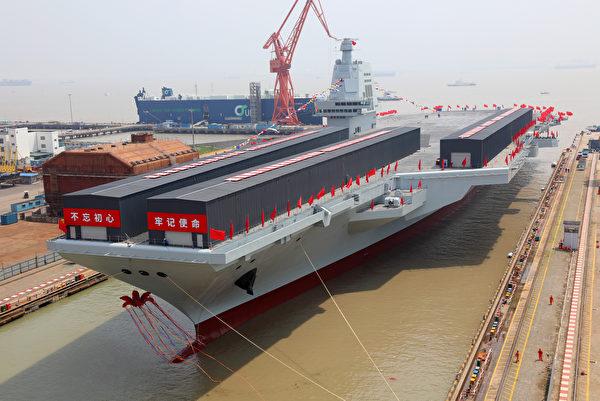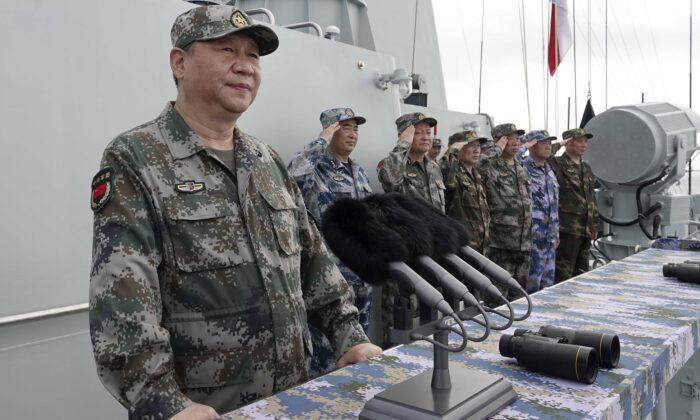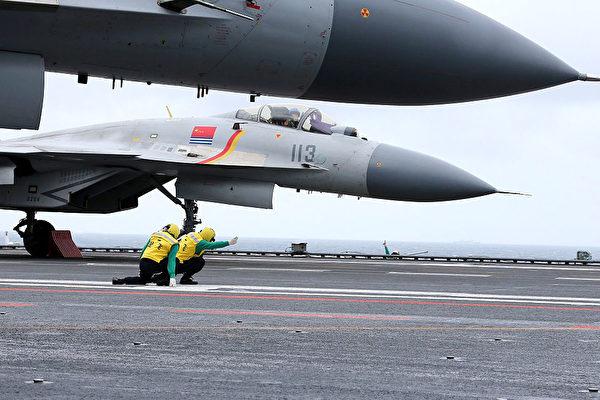Commentary
From April 1 to 2, Beijing conducted a hasty joint exercise near Taiwan, which was later named “Strait Thunder-2025A” before being quickly concluded.
The preparation for the exercise appeared rushed, and propaganda videos were used to fill in the gaps, revealing at least five major flaws, which may be directly related to internal turmoil within the Chinese military.
1. ‘Unified Command of Eastern Theater Command’?
China Central Television (CCTV), the Chinese Communist Party (CCP) mouthpiece, stated that “under the unified command of the Eastern Theater Command, the Shandong aircraft carrier strike group conducted exercises in the air and maritime space to the east of Taiwan Island, collaborating with forward-deployed air and naval forces on missions such as ship-aircraft coordination, area air superiority, and anti-ship and anti-land strikes.”
The state media report further stated that “The Eastern Theater Command successfully completed various joint training tasks around Taiwan Island, fully testing the integrated joint operational capabilities of the forces.”
During this exercise, the Shandong aircraft carrier fleet passed through the Bashi Channel and entered the southeastern waters of Taiwan, which should be considered a major highlight. The fleet accompanying the Shandong included one 055 destroyer, one 052D destroyer, one 054A frigate, and one supply ship. All these ships belong to the Southern Theater Command, and the Eastern Theater Command cannot effectively command them.
Once the Shandong aircraft carrier fleet left the South China Sea, it left the jurisdiction of the Southern Theater Command. The only entities that could truly command it would be the CCP’s Central Military Commission (CMC) or the Navy Headquarters.
The Eastern Theater Command is responsible for operations in the Taiwan Strait and the East China Sea, and it later claimed to have expanded its responsibilities to the Pacific. However, the Pacific region is too vast, and the Eastern Theater Command does not have the capability to control the entire Pacific. When the Shandong aircraft carrier fleet entered the Pacific, it theoretically entered the responsibility area of the Eastern Theater Command, yet the Eastern Theater Command had no authority to command it, as it was not during wartime.
After the 2016 military reforms, the major military regions were replaced by five military theaters, with the CMC clearly affirming “the CMC’s overarching leadership role, the Theater Commands’ responsibility for military operations, and the services’ focus on developing capabilities.”
This clearly distinguishes the authority and responsibilities between the military theaters and the services. The management of the forces of each military service is actually handled by the headquarters of the respective services, while the theaters are only responsible for combat operations. As long as there is no war, the theaters are essentially ineffective. Each theater has established army, navy, and air force agencies, but they still answer to the service headquarters, assisting in managing the forces within their respective regions, including training.
The headquarters of the Chinese Army, Navy, Air Force, Rocket Force, and support units are all located in Beijing, and they directly follow the commands of the CMC. The Rocket Force and various support units do not belong to any theater, so the Eastern Theater Command cannot command them. The military reform is essentially the dismantling of the original military regions, a reshuffling, with the real power being concentrated as much as possible within the CMC.
This time, the exercise should have been commanded by the CMC, yet they deliberately emphasized “unified command by the Eastern Theater Command.” On one hand, this may be an attempt to downplay the significance; on the other hand, it seems aimed at covering up rumors regarding the arrest of Eastern Theater Command Commander Lin Xiangyang, creating a sense that the Eastern Theater Command can still fight.
Such propaganda feels forced and somewhat low-level. The CCP’s theater system is practically difficult to operate. This is the first major flaw in the military exercise. If the CCP were to go to war in the Taiwan Strait, it’s hard to imagine the CMC allowing the “Eastern Theater Command to have unified command.”
2. Air Force Failed to Coordinate With Aircraft Carrier
According to Taiwan’s Central News Agency, the Ministry of National Defense of Republic of China (Taiwan’s official name) stated that from 6 a.m. on March 30 to 6 a.m. on March 31, they detected seven Chinese ships continuously operating around the Taiwan Strait; during this period, no Chinese aircraft were detected.
From 6 a.m. on March 31 to 6 a.m. on April 1, the Taiwanese military detected 19 Chinese ships continuing their activities around the Taiwan Strait; No Chinese aircraft were detected during this period either.
The Shandong aircraft carrier fleet should have passed through the Bashi Channel on the night of March 31 to April 1, entering the Pacific from the South China Sea, then proceeding to the southeastern waters of Taiwan about 220 nautical miles away. If the Eastern Theater Command were truly in “unified command,” the Eastern Theater Command Air Force should have promptly deployed a large number of fighter jets to provide air support for the Shandong aircraft carrier and escort it safely through the Bashi Channel. However, during the Shandong aircraft carrier’s passage through the channel, not a single aircraft from the Eastern Theater Command was deployed.
While Chinese military aircraft have significantly increased their frequency of harassment in the Taiwan Strait, often appearing in the southwestern airspace of Taiwan and approaching the Bashi Channel or circling around to Taiwan’s southeastern waters, in this joint exercise, the Eastern Theater Command’s fighter jets notably failed to cooperate in a timely manner with the Southern Theater Command’s aircraft carrier operations. This failure to present “integrated joint operations” at least demonstrates that the Chinese Air Force and Navy were unable to coordinate effectively.
The Bashi Channel is a dangerous area for China’s fleet, as both Taiwan to the north and the Philippines’ Batan Islands to the south have deployed anti-ship missiles, and Taiwanese fighter jets are always ready for airstrikes. The Philippines is also set to receive F-16 fighter jets soon. If the CCP were to truly prepare for war, U.S. fighter jets and bombers could be deployed early in Guam, Palau, and the Philippines to tightly block the channel. Chinese military aircraft have repeatedly harassed Taiwan’s southwestern airspace, displaying an intention to contest control of the airspace.
CCTV claimed the exercise included “naval and air forces coordinating for ship-aircraft cooperation, [and] regional air superiority,” and “fully tested the forces’ integrated joint operational capabilities.” However, the Eastern Theater Command’s Air Force failed to coordinate with the Southern Theater Command’s aircraft carrier in the Bashi Channel area. In a real combat scenario, this would leave the Shandong aircraft carrier to face enemy airstrikes and ground-based anti-ship attacks on its own.
In order to avoid detection, the Chinese fleet likely chose to pass through the Bashi Channel at night, making it difficult to launch or land carrier-based aircraft. The Eastern Theater Command Air Force likely wasn’t equipped for night operations, and for safety reasons, it probably decided not to deploy support aircraft. Everyone understands that this is merely a political display, not to be taken seriously, which exposed the second major flaw of this joint exercise.

3. Where Is Simulated Air Combat?
CCTV stated that “A formation of H-6K bombers, armed with live ammunition, crossed the Bashi Channel and advanced into the open sea, conducting multiple waves of simulated joint strikes on key military targets in the eastern part of Taiwan. To support the bomber formation, the Eastern Theater Command Air Force deployed multiple types and batches of fighter aircraft, organizing combat formations in the Taiwan Strait and the southwestern airspace of Taiwan to establish an air superiority combat system, create an airstrike corridor, and seize control of the regional airspace.”
According to Taiwan’s Ministry of National Defense, a large number of Chinese military aircraft appeared starting at 6 a.m. on April 1. By 6 a.m. on April 2, a total of 76 sorties had been flown, including 37 sorties over the Taiwan Strait, 15 sorties over northern Taiwan airspace, 4 sorties over southwestern airspace, 6 sorties over southeastern airspace, and 14 sorties by carrier-based aircraft.
The Eastern Theater Command Air Force still made only symbolic sorties. Most of the aircraft flew toward the Taiwan Strait median line and then turned back. Another portion appeared over northern Taiwan airspace, which had some significance, but by the next day, they largely disappeared.
The CCP claims to be contesting air superiority in the southwestern and southeastern Taiwan airspaces, with fighter jets escorting bombers. However, on the first day, the Chinese Air Force made the fewest sorties in the southwestern and southeastern Taiwan airspaces, with a total of 10 sorties, which is even fewer than the number of sorties flown by the Shandong aircraft carrier’s air group, that is, 14 sorties, including helicopters.
In the event of a war in the Taiwan Strait, the CCP would first need to contest control of northern Taiwan’s airspace to protect its landing fleet as it moves toward Taipei. Next, it would need to contest control of the southwestern Taiwan airspace to provide escort for bombers and its fleet moving through the Bashi Channel while trying to prevent U.S. military forces from intervening.
The Taiwan Strait airspace would be of secondary importance, as both sides have dense air defense missile systems. In real combat, no aircraft would dare to rush directly into the median line of the strait; any pilot who flies into the strait’s airspace to prepare for aerial combat would essentially be walking into a trap, let alone “opening an airstrike corridor.”
In this exercise, Chinese aircraft appeared most frequently over the Taiwan Strait, with fewer aircraft deployed in the southwestern Taiwan airspace. Despite this, the CCP claimed it was [to] “establish an air superiority combat system, [and] create an airstrike corridor” in the southwestern airspace, which diverged from a real combat scenario. This represents the third major flaw of the exercise.
4. Aircraft Carrier Incapable of Airstrike Missions
The CCP’s Eastern Theater Command Air Force not only failed to support the Shandong aircraft carrier but also did not deploy enough fighter jets to escort the bombers. In reality, it seemed more like the J-15 fighter jets on the Shandong aircraft carrier were simulating an escort role for the H-6 bombers in southeastern Taiwan.
This further underscores the CCP Navy’s predicament. Due to the limitations of the aircraft carrier’s ski-jump deck and the inherent shortcomings of the J-15, the Shandong aircraft carrier lacks ground-attack capabilities. The J-15 can only be used for fleet air defense, and it seems it had to work alongside the H-6 bombers to simulate an attack on eastern Taiwan.
On April 2, the CCP aircraft carried out 59 sorties, including 30 sorties in the Taiwan Strait, 2 in the northern airspace, 5 in the southwestern airspace, and 6 in the southeastern airspace, as well as 16 sorties of carrier-based aircraft.
The Eastern Theater Command Air Force mainly focused its efforts on the Taiwan Strait, with only 6 sorties reaching the southeastern airspace, yet the carrier-based aircraft launched 16 sorties. The true focus of the CCP’s two-day exercise was to simulate attacks on eastern Taiwan, but the carrier-based aircraft were unable to complete this task. The actual airstrike mission was carried out by H-6 bombers circling southern Taiwan, while the carrier-based aircraft mostly simulated escorting the bombers.
The CCP aircraft carrier once again exposed its serious flaw of being unable to carry out airstrike missions, which is the fourth major flaw in this exercise.

5. H-6 Bombers Struggle With Important Tasks
The CCP claimed that “A formation of H-6K bombers, armed with live ammunition, crossed the Bashi Channel and advanced into the open sea, conducting multiple waves of simulated joint strikes on key military targets in the eastern part of Taiwan.” The CCTV video depicted eastern Taiwan being bombed, and it deliberately showcased H-6 bombers carrying missiles. However, the number of bombers and fighters deployed by the CCP was limited, and the payload capacity of the bombers was also restricted, making the plan to strike eastern Taiwan seem unreliable.
The CCTV video showed that the H-6 bombers were only carrying two missiles, and the fighters were equipped with a maximum of four air-to-air missiles. During the exercise, the H-6 bombers risked flying through the Bashi Channel and circled around to simulate an airstrike on eastern Taiwan. However, in a real combat scenario, even if the bombers safely arrived, they would only be able to launch two missiles, making the scale of the attack very limited, and they could still be intercepted.
The CCP’s Air Force fighter jets have limited range, making it difficult for them to escort bombers around eastern Taiwan. This could have resulted in the Shandong aircraft carrier’s onboard fighter jets also participating in the escort mission. Such a complicated airstrike exercise, however, is unlikely to have much impact due to the limited payload capacity of the bombers.
Whether the CCP’s bombers could safely cross the Bashi Channel in a real combat scenario is uncertain. In the video, the H-6 bombers were shown carrying missiles that resemble the YJ-21 anti-ship missile rather than land-attack missiles like the CJ-10. This suggests the bombers were supposed to carry out anti-ship missions, not land-attack strikes.
Whether the CCP’s video was hastily assembled or was actually part of an exercise to simulate an airstrike on eastern Taiwan, the entire airstrike plan is merely theoretical, making it the fifth major flaw in the exercise.
Patchwork Propaganda’s Flaws
The CCP also claimed that the Eastern Theater Command’s artillery rocket units conducted simulations of precise strikes on important ports and energy facilities in Taiwan within the relevant waters of the East China Sea.
The CCP’s long-range rocket artillery still has limited range, and its rockets are not capable of precise strikes but only of saturation attacks. These should be deployed in locations as close as possible to Taiwan along the coast of Fujian Province, such as Pingtan Island or directly across from the Taiwan Strait.
However, the CCP claimed that the rocket artillery exercises took place in the East China Sea. If the rockets were indeed fired in live-fire exercises in the East China Sea, the rockets would have landed in the water, yet the video footage showed hits on ground targets. Where, exactly, were these rockets fired from, and where did they land?
The Taiwanese military, on the other hand, stated that they did not observe any live-fire exercises by the CCP.
The CCP’s propaganda flaws are not minor. They are outright fabrications. In the CCTV propaganda video, the Rocket Force is shown deploying, but no live ammunition was fired, making it impossible to determine when the video was filmed.
It’s likely that the CCP hastily decided to conduct this military exercise with insufficient preparation. As a result, their propaganda efforts were forced and unconvincing, leading to a number of noticeable inconsistencies.
The Shandong aircraft carrier, accompanied by a supply ship, entered the Pacific but quickly returned to the South China Sea after only two days. This exercise seems to have been yet another typical political task, wrapped up hastily after just two days.







